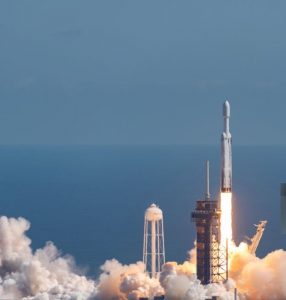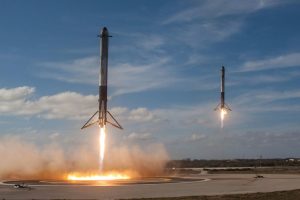Redefining The Landscape Of SpaceX Launch
 SpaceX has redefined the landscape of space exploration with its ambitious goals and groundbreaking technology. Through its innovative rockets and spacecraft, SpaceX continues to change the way we think about space missions. The company’s launches have become milestones in both commercial space and human spaceflight. This article delves into the details of SpaceX launches, focusing on key aspects of the company’s space missions.
SpaceX has redefined the landscape of space exploration with its ambitious goals and groundbreaking technology. Through its innovative rockets and spacecraft, SpaceX continues to change the way we think about space missions. The company’s launches have become milestones in both commercial space and human spaceflight. This article delves into the details of SpaceX launches, focusing on key aspects of the company’s space missions.
1) Rise of SpaceX launches
Founded in 2002 by Elon Musk, SpaceX had a clear goal: reduce the cost of space travel. The SpaceX launch was initially focused on developing the Falcon 1, the company’s 1st orbital rocket. After several challenges, the company succeeded in 2008, becoming the first privately funded entity to send a rocket into orbit.
From that moment, SpaceX expanded its ambitions. The company’s later rockets, including Falcon 9 and Falcon Heavy, would become central to its success. These launches showcased not just technological progress but the company’s ability to innovate at an unprecedented pace.
2) Falcon 9
The Falcon 9 is one of the most important milestones in SpaceX’s history. The rocket was designed to be reusable, lowering the cost of space missions. With each successful launch and landing, SpaceX proved that rockets could be recovered and reused. The first successful landing of a Falcon 9 rocket occurred in December 2015. This was a pivotal moment in reducing spaceflight costs and reshaping the space industry.
The Falcon 9’s design includes a two-stage rocket system. The first stage is capable of landing back on Earth after launch, while the second stage completes the mission in space. This reusable structure has become a symbol of SpaceX’s commitment to sustainability and efficiency in space exploration.
3) Falcon Heavy Launch
In 2018, SpaceX launched the Falcon Heavy, the world’s most powerful operational rocket. With its ability to carry 64 metric tons of cargo into orbit, Falcon Heavy was a significant upgrade over the Falcon 9. The launch was historic, as it surpassed the lifting power of previous rockets like NASA’s Saturn V.
Falcon Heavy has expanded the possibilities for space missions, particularly in terms of cargo capacity. SpaceX has used this powerful rocket for both commercial and government launches. Each Falcon Heavy launch has been a showcase of the company’s technological advancements and reliability in delivering large payloads into space.
4) Dragon Capsule in SpaceX Launches
The Dragon capsule has been a key component in SpaceX launches, particularly for missions to the International Space Station (ISS). It was designed to transport both cargo and crew members to the space station. Since 2010, Dragon has completed numerous successful cargo resupply missions for NASA.
In 2020, SpaceX made history by launching astronauts to the ISS using the Crew Dragon capsule. This mission marked the first time a private company had launched astronauts to the ISS. Crew Dragon represents the future of human spaceflight, and its launches are central to SpaceX’s strategy for human space exploration.
5) Reusability and cost reduction
The primary objective of SpaceX launches is reducing the cost of space travel. Reusability is at the core of this mission. SpaceX’s rockets are designed to return to Earth after launch and be reused for subsequent missions. The ability to land the first stage of a Falcon 9 rocket on solid ground or a drone ship at sea has greatly lowered the costs of launching payloads.
This reusability has allowed SpaceX to make significant strides in reducing the price of space access. SpaceX’s ability to reuse rockets allows the company to maintain a competitive advantage in the commercial space industry. This strategy has revolutionised the way private companies approach space missions and set new standards for cost efficiency in space.
6) Starship
SpaceX’s Starship project represents the next leap in space travel. Starship is a fully reusable spacecraft designed to carry both humans and cargo to destinations beyond Earth. It will be capable of traveling to the Moon, Mars, and even further into the solar system.
Starship’s design is ambitious. Made from stainless steel, the spacecraft is intended to be fully recyclable. SpaceX has already begun testing the Starship prototypes, with multiple successful test flights showing promising results. When fully operational, Starship could revolutionise human space exploration by enabling interplanetary travel.
7) SpaceX launches for NASA
SpaceX has built a strong partnership with NASA over the years. In 2020, SpaceX achieved a historic milestone by launching astronauts to the ISS aboard its Crew Dragon capsule. This launch marked the first crewed mission from U.S. soil since the retirement of the Space Shuttle in 2011.
NASA has relied on SpaceX for various space missions, including resupply flights and crew transportation. SpaceX has proven to be a reliable partner for NASA in both cargo and crew missions. This partnership has helped NASA expand its capabilities while driving SpaceX to new heights in space exploration.
8) SpaceX launches and commercial spaceflight
SpaceX has significantly impacted the commercial spaceflight industry. By reducing launch costs and providing reliable service, the company has attracted numerous customers for satellite launches, cargo missions, and other space projects. Commercial entities now have the ability to launch payloads into space more affordably.
The commercial satellite launch market has been a key source of revenue for SpaceX. Companies can now rely on SpaceX’s rockets for efficient, cost-effective launches. The ability to offer lower launch costs has made SpaceX a leader in the growing commercial space industry.
9) SpaceX’s Starlink
SpaceX’s most ambitious project is Starlink, a satellite-based internet service. Starlink aims to provide high-speed internet access to underserved and remote regions worldwide. The service relies on a network of low-Earth orbit (LEO) satellites to deliver fast and reliable internet access.
To support Starlink, SpaceX has launched thousands of satellites into orbit. These launches are conducted regularly, with a constant stream of Starlink satellites being added to the network. The Starlink project has the potential to transform global internet access, particularly for rural and remote communities.
10) SpaceX launches for national security and military missions
SpaceX has also secured contracts with the U.S. government for national security and military missions. The company has launched satellites for the Department of Defense and other government agencies. These missions require the highest levels of reliability and security, and SpaceX has consistently met these demands.
SpaceX’s role in national security extends beyond satellite launches. The company’s rockets are also used for sending spacecraft to monitor Earth, collect data, and support defense systems. As the U.S. military continues to expand its space capabilities, SpaceX remains a key partner in these efforts.
Paving the way for interplanetary travel
SpaceX has reshaped the space industry with its revolutionary rocket technology, reusability, and ambitious goals. The company’s launches have gone from sending cargo to the ISS to launching astronauts and satellites into orbit. With the development of Starship and its ongoing partnership with NASA, SpaceX continues to push the boundaries of what is possible in space exploration.
As the company works toward making interplanetary travel a reality, the potential for SpaceX launches is limitless. The successful launches of Falcon 9 and Falcon Heavy have demonstrated the feasibility of reusable space vehicles. With Starship, SpaceX is preparing to take humanity beyond Earth and into the stars. The future of space travel is bright, and SpaceX’s launches will continue to lead the way.










